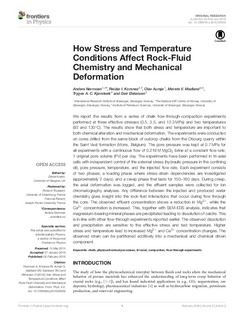| dc.contributor.author | Nermoen, Anders | |
| dc.contributor.author | Korsnes, Reidar I. | |
| dc.contributor.author | Aursjø, Olav | |
| dc.contributor.author | Madland, Merete V. | |
| dc.contributor.author | Kjørslevik, Trygve A.C. | |
| dc.contributor.author | Østensen, Geir | |
| dc.date.accessioned | 2017-08-16T07:22:53Z | |
| dc.date.available | 2017-08-16T07:22:53Z | |
| dc.date.issued | 2016-03 | |
| dc.identifier.uri | http://hdl.handle.net/11250/2450831 | |
| dc.description.abstract | We report the results from a series of chalk flow-through-compaction experiments performed at three effective stresses (0.5, 3.5, and 12.3MPa) and two temperatures (92 and 130◦C). The results show that both stress and temperature are important to both chemical alteration and mechanical deformation. The experiments were conducted on cores drilled from the same block of outcrop chalks from the Obourg quarry within the Saint Vast formation (Mons, Belgium). The pore pressure was kept at 0.7MPa for all experiments with a continuous flow of 0.219M MgCl2 brine at a constant flow rate; 1 original pore volume (PV) per day. The experiments have been performed in tri-axial cells with independent control of the external stress (hydraulic pressure in the confining oil), pore pressure, temperature, and the injected flow rate. Each experiment consists of two phases; a loading phase where stress-strain dependencies are investigated (approximately 2 days), and a creep phase that lasts for 150–160 days. During creep, the axial deformation was logged, and the effluent samples were collected for ion chromatography analyses. Any difference between the injected and produced water chemistry gives insight into the rock-fluid interactions that occur during flow through the core. The observed effluent concentration shows a reduction in Mg2+, while the Ca2+ concentration is increased. This, together with SEM-EDS analysis, indicates that magnesium-bearing mineral phases are precipitated leading to dissolution of calcite. This is in-line with other flow-through experiments reported earlier. The observed dissolution and precipitation are sensitive to the effective stress and test temperature. Higher stress and temperature lead to increased Mg2+ and Ca2+ concentration changes. The observed strain can be partitioned additively into a mechanical and chemical driven component. | nb_NO |
| dc.language.iso | eng | nb_NO |
| dc.publisher | Frontiers Media S.A. | nb_NO |
| dc.rights | Navngivelse 4.0 Internasjonal | * |
| dc.rights.uri | http://creativecommons.org/licenses/by/4.0/deed.no | * |
| dc.subject | chalk | nb_NO |
| dc.subject | physicochemical processes | nb_NO |
| dc.subject | tri-axial | nb_NO |
| dc.subject | compaction | nb_NO |
| dc.subject | flow-through experiments | nb_NO |
| dc.title | How stress and temperature conditions affect rock-fluid chemistry and mechanical deformation | nb_NO |
| dc.type | Journal article | nb_NO |
| dc.type | Peer reviewed | nb_NO |
| dc.description.version | publishedVersion | nb_NO |
| dc.rights.holder | Copyright © 2016 Nermoen, Korsnes, Aursjø, Madland, Kjørslevik and Østensen. | nb_NO |
| dc.subject.nsi | VDP::Matematikk og Naturvitenskap: 400::Fysikk: 430 | nb_NO |
| dc.source.volume | 4 | nb_NO |
| dc.source.journal | Frontiers in Physics | nb_NO |
| dc.source.issue | 2 | nb_NO |
| dc.identifier.doi | 10.3389/fphy.2016.00002 | |

